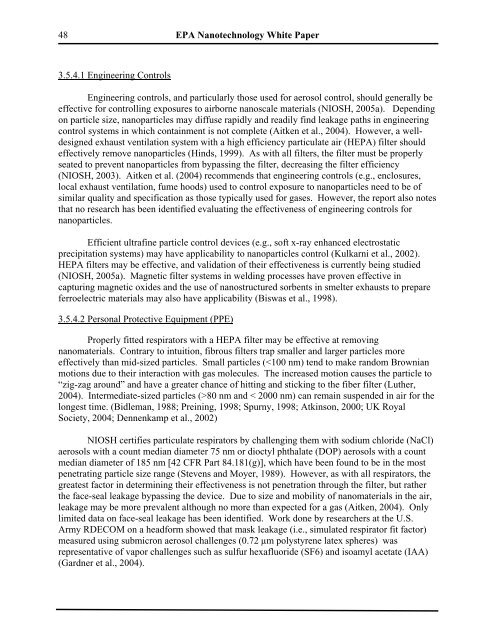Nanotechnology White Paper - US Environmental Protection Agency
Nanotechnology White Paper - US Environmental Protection Agency
Nanotechnology White Paper - US Environmental Protection Agency
You also want an ePaper? Increase the reach of your titles
YUMPU automatically turns print PDFs into web optimized ePapers that Google loves.
48 EPA <strong>Nanotechnology</strong> <strong>White</strong> <strong>Paper</strong><br />
3.5.4.1 Engineering Controls<br />
Engineering controls, and particularly those used for aerosol control, should generally be<br />
effective for controlling exposures to airborne nanoscale materials (NIOSH, 2005a). Depending<br />
on particle size, nanoparticles may diffuse rapidly and readily find leakage paths in engineering<br />
control systems in which containment is not complete (Aitken et al., 2004). However, a welldesigned<br />
exhaust ventilation system with a high efficiency particulate air (HEPA) filter should<br />
effectively remove nanoparticles (Hinds, 1999). As with all filters, the filter must be properly<br />
seated to prevent nanoparticles from bypassing the filter, decreasing the filter efficiency<br />
(NIOSH, 2003). Aitken et al. (2004) recommends that engineering controls (e.g., enclosures,<br />
local exhaust ventilation, fume hoods) used to control exposure to nanoparticles need to be of<br />
similar quality and specification as those typically used for gases. However, the report also notes<br />
that no research has been identified evaluating the effectiveness of engineering controls for<br />
nanoparticles.<br />
Efficient ultrafine particle control devices (e.g., soft x-ray enhanced electrostatic<br />
precipitation systems) may have applicability to nanoparticles control (Kulkarni et al., 2002).<br />
HEPA filters may be effective, and validation of their effectiveness is currently being studied<br />
(NIOSH, 2005a). Magnetic filter systems in welding processes have proven effective in<br />
capturing magnetic oxides and the use of nanostructured sorbents in smelter exhausts to prepare<br />
ferroelectric materials may also have applicability (Biswas et al., 1998).<br />
3.5.4.2 Personal Protective Equipment (PPE)<br />
Properly fitted respirators with a HEPA filter may be effective at removing<br />
nanomaterials. Contrary to intuition, fibrous filters trap smaller and larger particles more<br />
effectively than mid-sized particles. Small particles (80 nm and < 2000 nm) can remain suspended in air for the<br />
longest time. (Bidleman, 1988; Preining, 1998; Spurny, 1998; Atkinson, 2000; UK Royal<br />
Society, 2004; Dennenkamp et al., 2002)<br />
NIOSH certifies particulate respirators by challenging them with sodium chloride (NaCl)<br />
aerosols with a count median diameter 75 nm or dioctyl phthalate (DOP) aerosols with a count<br />
median diameter of 185 nm [42 CFR Part 84.181(g)], which have been found to be in the most<br />
penetrating particle size range (Stevens and Moyer, 1989). However, as with all respirators, the<br />
greatest factor in determining their effectiveness is not penetration through the filter, but rather<br />
the face-seal leakage bypassing the device. Due to size and mobility of nanomaterials in the air,<br />
leakage may be more prevalent although no more than expected for a gas (Aitken, 2004). Only<br />
limited data on face-seal leakage has been identified. Work done by researchers at the U.S.<br />
Army RDECOM on a headform showed that mask leakage (i.e., simulated respirator fit factor)<br />
measured using submicron aerosol challenges (0.72 µm polystyrene latex spheres) was<br />
representative of vapor challenges such as sulfur hexafluoride (SF6) and isoamyl acetate (IAA)<br />
(Gardner et al., 2004).

















